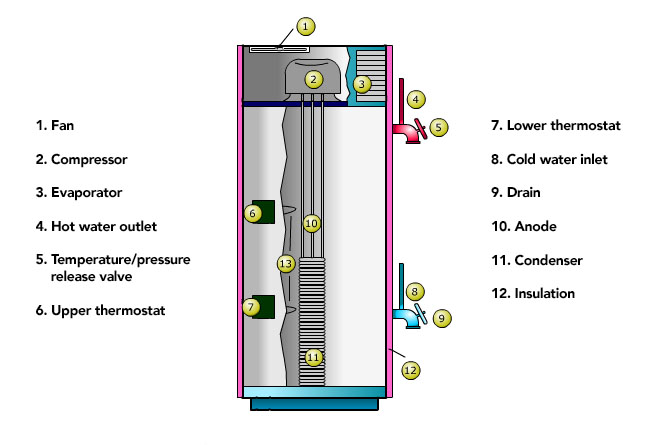Heat pumps are a well-established technology for space heating. The same principle of transferring heat is at work in heat pump water heaters (HPWHs) except that they extract heat from air (indoor, exhaust, or outdoor air) and deliver it to water. Some models come as a complete package, including tank and back-up resistance heating elements, while others work as an adjunct to a conventional water heater.
The simplest HPWH is the ambient air-source unit, which removes heat from surrounding air, providing the additional benefit of space cooling. Exhaust air units extract heat from a continuously exhausted air stream and work better in heating-dominated climates because they do not cool ambient air. Some units can even be converted between the two modes of operation for optimum operation in either summer or winter.
In mild climates, you can place ambient air-source units in unheated but protected spaces such as garages, essentially using outdoor air as a heat source.

Because it extracts heat from air, the HPWH delivers about twice the heat for the same electricity cost as a conventional electric resistance water heater.
Parts of a Heat Pump Water Heater (HPWH)

Desuperheaters
The Desuperheater feature is available on some central air conditioners and is a variation of the stand-alone HPWH. It provides economical supplemental water heating as a byproduct of air conditioning.
Desuperheater water heating can be part of an integrated package with a heat pump or air conditioner system. In most such systems, the heat pump water heating only occurs during normal demand for space conditioning, with resistance electric coils providing water heating the rest of the time.
During the cooling season, the Desuperheater actually improves the efficiency of the air conditioning system while heating water at no direct cost. In an average climate, a desuperheater might meet 20 to 40 percent of annual water heating demand.
Heat pump water heaters can provide up to 60 percent energy savings over conventional water heaters.
How a Heat Pump Water Heater Works
The HPWH consists of three circuits. The HPWH consists of three circuits. Watch the video below to learn more about how a HPWH works.
Click here for a text description of How a Heat Pump Water Heater Works
How a Heat Pump Water Heater Works
The heat pump water heater (HPWH) consists of three circuits; a Heat Pump circuit, a Geothermal Heat circuit, and a Desuperheater circuit.
The Heat Pump circuit consists of an indoor coil, a compressor, and a Desuperheater. Cool water flows from the indoor coil to the compressor. The water becomes heated as it travels through the compressor to the Desuperheater. The heat from the water is transferred to the water in the Desuperheater circuit through the adjacent coils.
The cool water then flows to the coils adjacent to the Geothermal Heat circuit and becomes heated as it flows back to the indoor coil.
The Geothermal heat circuit consists of a geothermal unit in the ground, a "from earth connection," and a "to earth connection." Water warmed by the earth flows from the "from earth connection" through the coils adjacent to the Heat Pump circuit, transferring the heat energy. The cool water flows back into the geothermal unit in the ground.
The Desuperheater circuit consists of the hot water tank that supplies water to the house and a set of coils adjacent to the Desuperheater coils in the Heat Pump circuit. The water from the tank cycles through the coils and is heated by the Heat Pump circuit.
Note: The concept shown in the animation is applicable to all HPWH: heat is picked up and delivered into some source – which could either be the ground, air, or water.
Most of the heat delivered to the water comes from the evaporator of the unit, not through the electrical input to the machine. Consequently, the efficiency of the HPWH is much higher than for direct-fired gas or electric storage water heaters.
The installed cost of commercial HPWH systems is typically several times that of gas or electric water heaters; yet the low operating costs can often offset the higher total installed cost, making the HPWH the economic choice for water heating.
The HPWH becomes increasingly attractive in building applications where energy costs are high, and where there is a steady demand for hot water. This attractiveness is less a function of building type than it is of water demand and utility cost.